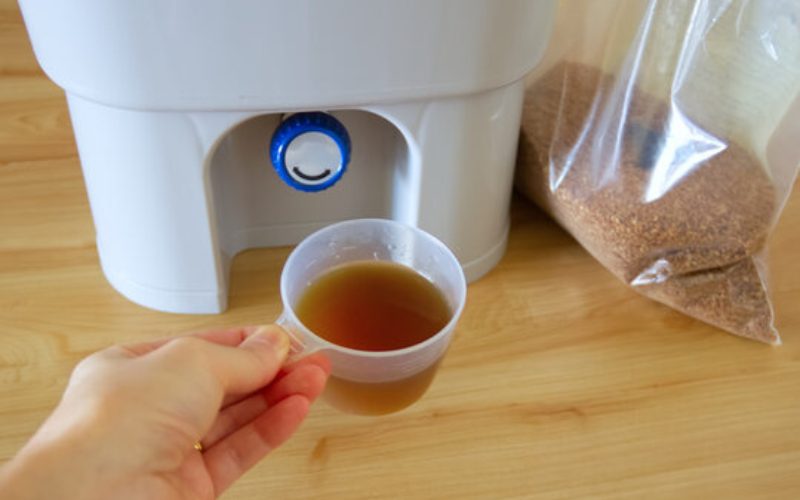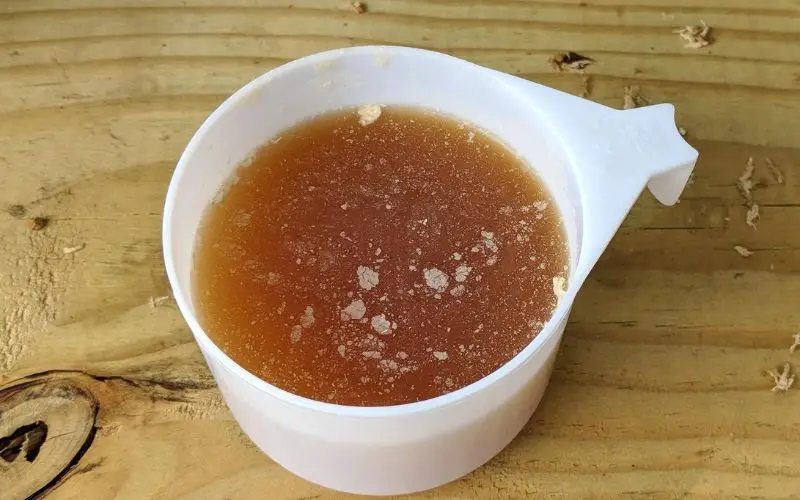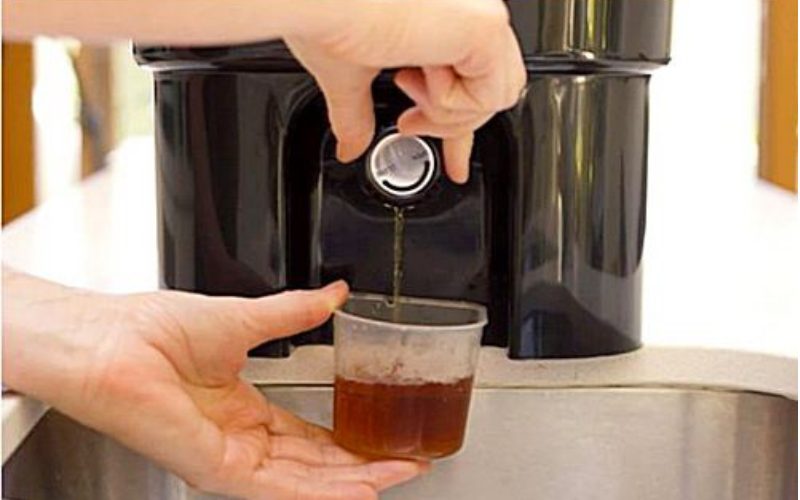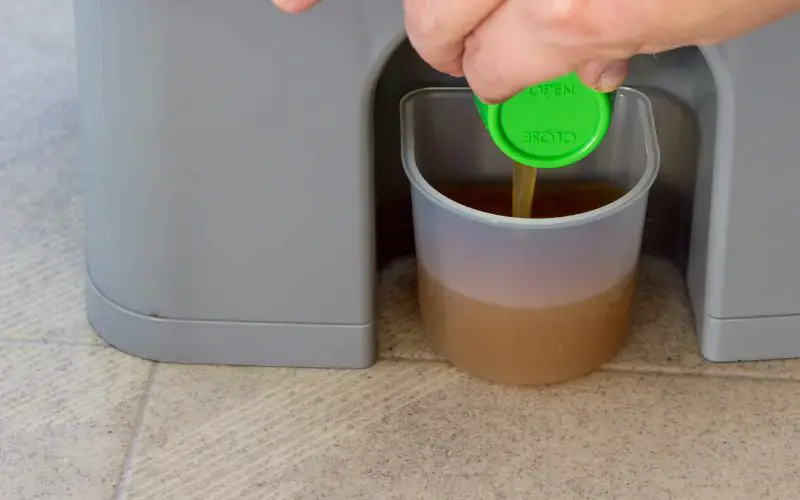If you’ve got lots of kitchen scraps and are looking for an easy and fast way to turn them into nutrient-rich manure for your garden, then bokashi tea is it for you.
In the same way, a good cup of tea can make you warm and invigorated, so this tea improves your garden.
Using bokashi tea is an easy and better way to compost at home, and the good news is that it takes just a fraction of the time it takes your regular compost to be ready.
With your bokashi bran, buckets, and kitchen scraps, you are on your way to giving your garden a nutritional upgrade.
What Is Bokashi Tea?

In the 1980s, Dr. Teruo Higa developed a composting technology in which food scraps, organic waste, and bokashi bran are kept in an air-tight container. The liquids are periodically drained off and used as liquid fertilizers. That liquid fertilizer is what is known as bokashi tea.
In the real sense, bokashi tea can be described as a fermentation product if bokashi bran and food scraps are in an air-tight container. That is because the tea is a product of an anaerobic process that takes advantage of certain strains of bacteria that don’t need oxygen to thrive.
The bokashi bran speeds up fermentation because it is infused with bacteria that act on kitchen scraps. The bokashi tea-making process harnesses the power of microorganisms to break down food waste through fermentation.
The main bacteria in the bokashi bran that ferment food scraps are called the “big 3” of EM-1 and lactobacillus, the same ones that ferment milk into yogurt. The others are yeast and Phototrophic bacteria.
Merits Of Bokashi Composting
The process of making bokashi tea is known as bokashi composting. It is a very beneficial process with more advantages than the traditional composting methods. Some of these advantages include the following:
They are quicker
The fact that in a matter of 2 weeks, you can get bokashi tea for your garden is the main reason many go for this liquid fertilizer. Normal composting takes several months to be ready for use, but bokashi composting saves you the stress of waiting too long before you can “feed your garden.”
It Hardly Stinks
Most traditional composting methods produce a solid repugnant odor (mainly if the composting process is not done correctly). Still, with bokashi composting, you are not bothered by an odorous stench because the fermentation process is done in an air-tight container.
It Doesn’t Need A Lot Of Maintenance
With regular composting, you have to check that there is a balance between green and brown compost materials, you have to turn the pile from time to time, and you generally have to monitor the compost. Still, with bokashi, you just put the food scraps in the bucket, drain the water when it’s ready, and the tea is ready.
It Doesn’t Take A Lot Of Space
You can only do composting if you live in an apartment or any area that has a good-sized. It is different from making bokashi tea. The container is sometimes so small it can fit on a kitchen countertop.
You Can Compost Lost Of Things
Some materials cannot be composted with regular composting, meat, and dairy products, but with bokashi composting, there is hardly any limit to what food scraps you can compost.
Bokashi Tea is Loaded With Nutrients
Bokashi tea is a vibrant nutrient supplement for your garden because it contains many nutrients plants need to thrive.
Uses Of Bokashi

There are some uses of bokashi that many people need to learn. All you might know about this material is that it supplies nutrients to your garden. Here are a few other uses of bokashi.
It Helps The Septic System
If the septic system in your home breaks down waste slowly, the system can get a boost if you add some bokashi tea to it, especially the tea with many microbes.
It Can Clean Up The Pipes Of Your Drain.
Are you constantly having a problem with a clogged drain in your home? It may be time to take care of the problem by pouring some bokashi tea through the sink.
Bokashi tea is acidic, so it acts as a drain cleaner. Secondly, the microbes it contains help break down any of the things that usually clog drains, like fat, hair, food particles, etc. In addition to pipes, bokashi tea can clean and reduce the smell of in-sink garbage disposals.
They Are Plant Food
It is the principal reason why most people make bokashi tea. It is rich in nutrients. The nutrient content of the scraps that ferment to make bokashi tea determines the nutrient richness of the bokashi in tea and what nutrients they supply to the plants. It also increases the number of microbes and their activities in the soil.
It Improvement Sanitation For Pens
When used in dog runs and chicken pens, bokashi tea (EM-1) microbes have been proven to reduce odor and sanitize animal pens.
It Can Act As A Compost Starter
All composting methods rely on microbes to break organic matter down. You can use bokashi to speed up the composting process in traditional compost because they will introduce the microbes that will help the composting process kick-start.
How To Use Bokashi Tea

To use bokashi tea, you will have to make it first. The steps below show you how to make and use bokashi tea.
Get All The Materials You Need
To make bokashi tea, you will need the following:
- Bokashi bran
- Bokashi bucket (it’s an air-airtight bucket with a drainage spout)
- Food scraps
Other compost materials
The bokashi bucket creates an anaerobic environment and offers easy drainage, while the bokashi bran will supply the beneficial microbes that will help break down the organic matter.
You could get the BokashiPro Starter Kit which includes two buckets with filters, a masher, and a cup for collecting the compost “tea.”
The bokashi bran, also called bokashi flakes, is a mixture of beneficial microbes with water, sugar, and a medium, usually wheat bran. You can buy Bokashi bran from natural living stores or garden stores.
Fill the Bokashi Bucket
All the food scraps added to the bokashi bucket, including vegetables, fruits, leftovers, and even dairy, meat, and oils into the bucket with a handful of bran. Then use the masher to keep them firmly pressed until it is flat and every air bubble is squeezed out.
Sprinkle another bran layer on the food scrap and then replace the lid. You should follow the same process anytime you want to add more food scraps.
Set The Bokashi Bucket Aside
When the Bokashi Bucket is complete, keep the bucket under the sun, ensuring it is air-tight for about two weeks. Never open the buckets because air will put a spanner in the fermentation process.
Since the BokashiPro Starter Kit includes buckets, set them aside to ferment once you finish one bucket and then start with the second Bokashi bucket.
Now Collect Your Bokashi Tea
The Bokashi bucket colleagues to the Bokashi tea or juice at the bottom of the bucket as the fermentation process continues. All you must do is use the fixture and the cup to drain the liquid every other day or so to ensure that the fermentation process continues uninhibited by the water. This liquid will need to be diluted before it goes into your garden.
Using The Bokashi Tea
It would be best to dilute Bokashi liquid before using it for plants or soil. The ratio of water to the amount of bokashi used is in the ratio 100:1, or you can add one teaspoon of tea to 2 liters of water.
It makes a liquid fertilizer with the proper acid level safe for plants. Even when the liquid fertilizer is diluted, it is still unsafe for tender plants or their foliage. Instead, you should add them to the soil surrounding the plants.
The nutrients of many soils are sometimes inaccessible to plants because they are in a form that ate unusable by plants. Still, when this bokashi tea is applied to such soils, their microbes help make these nutrients available to the plants by forming a symbiotic relationship with the plant roots and providing them with necessary nutrients.
Using The Compost
It takes about 10 to 14 days for your bokashi compost to be ready, the food scrap might look the same, but you can be sure that fermentation has transformed it into a pre-compost.
It cannot go into your garden because it is still too acidic. You have to bury the content of the bokashi bucket and leave it for about two weeks before applying it to your soil, where it will supply the vital nutrients your plants need.
Afterward, rinse your bokashi bucket and make more tea for your beloved plants.
Conclusion
With bokashi composting, recycling food waste into compost and fertilizer has never been faster or easier. It doesn’t require a lot of technical skills, it is relatively inexpensive, and you can compost almost any of your kitchen waste without ever perceiving the stench of decaying organic matter in less than two weeks and one month, you have that nutrient-rich bokashi tea and compost respectively.
Helpful Links:
- Patio Floods When it Rains
- Can you Unplug a Hard Wired Smoke Detector
- How to Kill a Palm Tree
- How to Make your Shower Paint Last Longer
- Can you put an Outdoor Rug on Grass
Follow us on Facebook, Instagram, and Pinterest for more updates.

